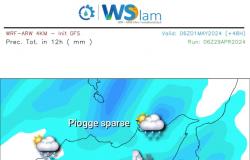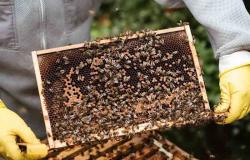AGI – Atomic laboratories, solar power plants, wind tunnels, huge dams, oil platforms, even the Facebook data processing center, with The Cloud: they are the subject of Kim Steele’s extraordinary photographs, a photographer from San Francisco, in Rome these days and who, at Palazzo Ripetta, presented a taste of his work. Son of a US Air Force fighter pilot from whom he inherited a passion for the monumentality of American industrial power, Steele arrived on the vibrant scene of 1980s New York at a time of great cultural and economic ferment: within just a year ago he began to publish in Life Magazine, but above all to frequent Andy Warhol’s Factory, a meeting place for artists and a hotbed of ideas.
A great friend of Madonna, even before that of Jean-Michel Basquiat and Keith Haring, today he exhibits his works in some of the largest museums in the world (starting with the MoMa in New York) and in numerous corporate collections (among others, those of Chase Manhattan Bank and Goldman Sachs). In Rome because he is passionate about Italy (he also worked on a series dedicated to ancient olive trees), he presented at Palazzo Ripetta, in collaboration with the neighboring Academy of Fine Arts, the black and white shots collected in his book ‘American Industry’, published just a year ago by Goff Books.
Steele’s message to the Romans
The event, promoted by the Academy of Fine Arts in collaboration with Palazzo Ripetta, was an opportunity to observe spectacular images of places often inaccessible to the general public, which are witnesses of human progress and scientific research: shots that document the effort human and economic in the nuclear industry, space aeronautics, engineering, but also testify to the social and environmental costs of progress; and they question the possibility that a new idea of sustainable development could exist.
A snapshot of opulence, that of the American giant, today in crisis; or the rampant economic growth of countries like China, with its successes but also environmental degradation. Some photos are iconic: that of the Three Gorges Dam, for example, the most colossal work created in China in recent centuries, a work that certainly marks an environmental milestone (because the power plant connected to it allows for annual savings of tens million tons of greenhouse gases), but whose construction had a devastating environmental impact. Or, in the USA, in the State of Washington, Hanford Site, where there are 9 reactors for the production of plutonium, now abandoned, including the one built for the production of the plutonium used for the first atomic bomb, Fat Man, the bomb which devastated Nagasaki, Japan. Today it is the most contaminated nuclear site in the USA, the subject of a decontamination project of gigantic proportions (President Joe Biden has just decided on a historic allocation of three billion dollars). Or the Trident Laser of Los Alamos, New Mexico, the laboratory where JR Oppenheimenr, the father of the atomic bomb, led the Manhattan Project.
The photos have a great visual impact: “They document places that cannot be visited and which are conveyed by a single and unique gaze, which makes us understand what is behind them. The Academy works precisely on this, not on appearance , but on what is behind the image”, observed Cecilia Casorati, director of the Academy of Fine Arts. “I often invite national and international artists to the Academy to give objectives to the children, who appreciate them because they can visualize a possible career”, explained Riccardo Ajossa, professor of Paper Technologies.
The meeting was an appointment included in the cycle of events (many others are still on the agenda) organized together by the Academy and Palazzo Ripetta. “Ours is an alliance between neighbors, in the name of contemporary art“, recalled Miriam Mirolla, head of external relations of the Academy. “Cultural events that embrace various fields, not just artistic ones“, echoed the owner of the house, the CEO of Palazzo Ripetta, Giacomo Crisci. The area in which both Palazzo Ripetta and the Academy overlook is that of the Roman Trident which winds around via di Ripetta, a place of frequenting of tourists, but also for artists, enriched by the presence of over 4 thousand students enrolled at the Academy. The Academy itself has recently opened a new museum space, open to the public and accessible for free, on Piazza del Ferro di Cavallo and the Gallery; it currently houses works by Jannis Kounellis, who was a brilliant student of the school in the 1950s and today is one of the leading contemporary artists.
Tags: industry art Kim Steeles photographs Rome






